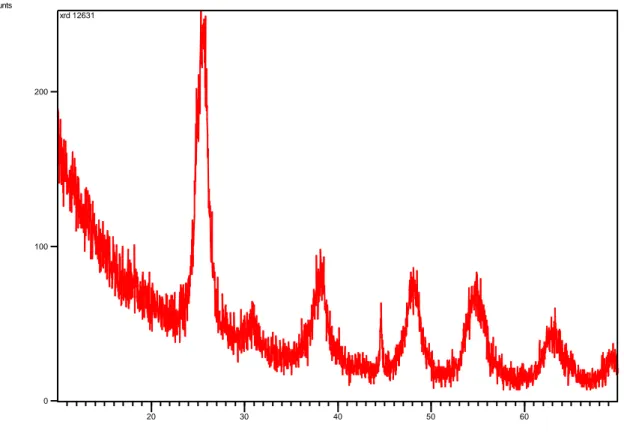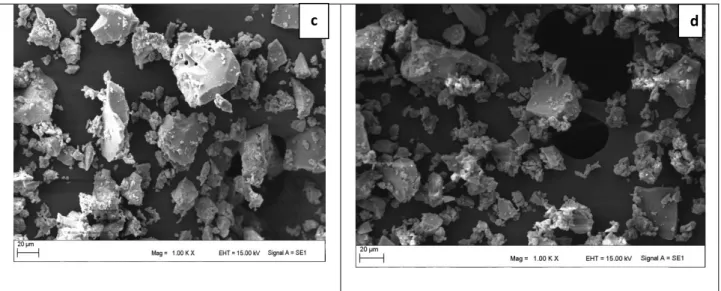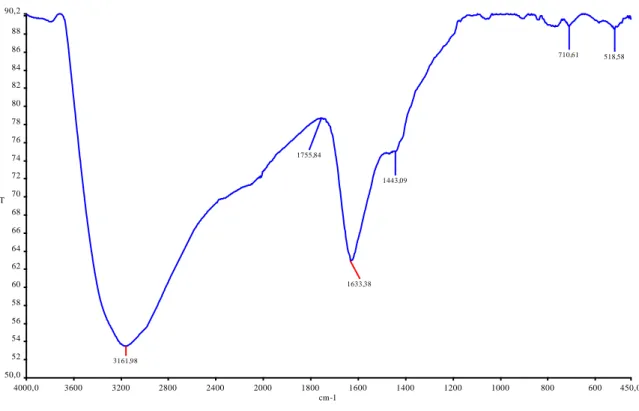Kahramanmaras Sutcu Imam University
Journal of Engineering Sciences
Geliş Tarihi : 14.08.2020 Received Date : 14.08.2020
Kabul Tarihi : 23.10.2020 Accepted Date : 23.10.2020
TİTANYUM DİOKSİT SENTEZİ (TİO
2)
SYNTHESIS OF TITANIUM DIOXIDE (TİO
2)
Serdar GÖÇER1 (ORCID: 0000-0003-0443-8045)
Binnaz Zeynep ZAİMOĞLU,1
(ORCID: 0000-0002-9573-4781)
Kevser CIRIK2* (ORCID: 0000-0002-1756-553X)
1 Department of Environmental Engineering, Çukurova University, Adana, Turkey
2 Department of Environmental Engineering, Kahramanmaras Sutcu Imam University, Kahramanmaras, Turkey
*Sorumlu Yazar / Corresponding Author:Kevser CIRIK, kcirik@ksu.edu.tr
ÖZET
Titanyum dioksit (TiO2), çevre dostu, sentezi kolay, stabil ve ucuz bir katalizör olarak, çoğunlukla su arıtımı gibi
çevresel iyileştirme amaçlı hafif aktiviteye sahip bir katalizör olarak kabul edilmektedir. Bu çalışmada, TiO2,
kristal yapıları belirlemek için X-Ray difraksiyon cihazı (XRD), enerji dağıtıcı X-ışını spektroskopisi (EDX) ile donatılmış taramalı elektron mikroskobu (SEM), parçacık boyutunu belirlemek için BET analizi, ve bağları belirlemek için FT-IR analizi kullanılarak sentezlenmiş ve karakterize edilmiştir. Sonuçlar, 2θ piklerde 25o, 38o,
48o'de TiO
2 nanopartiküllerinin varlığı tespit edilirken, 65o ve 70o piklerde TiO tespit edildiğini göstermektedir.
EDX analizi sonuçlarına göre; Ti, O, Au ve C elementleri belirlenmiştir. FT-IR analizine göre, 450 cm-1'de oluşan
pik TiO2 varlığını gösterir. BET analizine göre; TiO2'nin yüzey alanı 65 m2/g olarak belirlendi ve bu ticari TiO2'den
(40 m2/g) önemli ölçüde yüksektir. Sonuçlar, literatürde kullanılanlara göre azalan sıcaklıklarda TiO
2 elde etmenin
mümkün olduğunu göstermektedir. Ek olarak, oda sıcaklığında sentezlenen TiO2 karakterizasyonu, yüksek
sıcaklıklarda (>400Co) gerçekleştirilen önceki çalışma sonuçlarından elde edilen sonuçlarla karşılaştırıldığında
benzerdir.
Anahtar Kelimeler: Titanyum Dioksit, Nanopartiküller, Titanyum Dioksit Sentezi ABSTRACT
Titanium dioxide (TiO2) is regarded as an environmentally friendly, easy-to-synthesis, stable and inexpensive
catalyst, often as a mildly active catalyst for environmental improvement purposes such as water treatment. In this study, TiO2 was synthesized and characterized using an X-Ray diffraction instrument (XRD) to determine the
crystal structures, scanning electron microscopy (SEM), equipped with energy-dispersive X-ray spectroscopy
(EDX), BET analysis to determine particles size, and FT-IR analysis to determine bonds TiO2. Results show that
while the presence of TiO2 nanoparticles at 25o, 38o, 48o at 2θ peaks was detected, TiO was detected at 65o and 70o
peaks. According to the results of EDX analysis; Ti, O, Au, and C elements are detected. According to FT-IR
analysis, the peak formed at 450 cm-1 shows the presence of TiO
2. According to BET analysis; the surface region of
TiO2 was identified as 65 m2/g which was significantly higher than that of commercial TiO2 (40 m2/g). The results
show that it is acceptable to achieve TiO2 at decrease temperatures according to those used in the literature.
Additionally, the characterization of synthesized TiO2 at room temperature is similar compared to the results
obtained from previous study results that have been conducted under high temperatures (>400oC). Keywords: Titanium Dioxide, Nanoparticles, Titanium Dioxide Synthesis
*Sorumlu Yazar / Corresponding Author:Kevser CIRIK, kcirik@ksu.edu.tr
To Cite: GOCER S., ZAİMOGLU, Z., & CIRIK, K., (2020). TİTANYUM DİOKSİT SENTEZİ (TİO2). Kahramanmaraş
1. INTRODUCTION
Titanium dioxide nanoparticles are among the most used nanomaterials due to their high stability, anti-corrosion properties, surface activities, and photocatalytic properties. These properties appear as stable for the extensive use of TiO2 substances in diverse areas including light activity, hydrogen production, and such as wastewater treatment.
(Burke, A., et al., 2008; Nakata, K., et al., 2013; G.L. Chiarello, et al., 2017; W. Zhou, et al., 2014; Z. Xing, et al., 2018). In recent years, optical and electronic characteristics of nanomaterials, which become severely size dependant have attracted attention to the preparation of nanoparticle semi-conductors (M. Tomkiiewicz, 2000). Titanium nanoparticles with very thin dimensions are encouraging in many practices such as wastewater treatment, adsorbents, and catalytic fields (G. Ramakrishna, 2003; M.M. Rahman, et al., 1999; E. Pelizzetti, et al., 1993). In almost all of these conditions, when the particle size is reduced greatly, due to the large surface area, some recent optical properties can be expected (S. Sahni, et al., 2007). The synthesis of titanium dioxide nanoparticles consists of four different methods; these, sol-gel process (Q. Zhang, L. Gao, 2003), hydrothermal methods (P.D. Cozzoli, et al., 2003), solvothermal methods (C.S. Kim, et al., 2003), and emulsion precipitation (G. Ramakrishna, H.N. Ghosh, et al., 2003). Many of them were succeeded by synthesizing high purity of (>99%) TiO2. However, it is
important to be easily reproducible at the industrial level by avoiding dangerous reagents (Zadeh, E.K, et al.,2017; Mezni, A., et al., 2017; Ojeda, M., et al., 2017; Lusvardi, G., et al., 2017). By using this approach, the purpose of this study was the synthesis and characterization of TiO2 nanoparticles by avoiding harmful chemicals.
In this study, TiO2 was synthesized in a procedure containing 50 mL titanium isopropoxide (C12H28O4Ti), ≥99.8,
200 mL H2O, and 1gr CO(NH2)2. The materials characterization was performed using an X-Ray diffraction
instrument (XRD) to determine the crystal structures of TiO2 particle, SEM, EDX, and BET analysis to determine
particle size and crystal properties, FT-IR analysis to determine chemical bonds TiO2. 2. MATERIAL AND METHODS
2.1. Preparations of Titanium Dioxide (TİO2)
The procedure reported in the literature have been tested and (Lusvardi, G., et al., 2017). TiO2 synthesis was carried
out with the best, simplest, and cheapest procedure. The used reagents are titanium isopropoxide (C12H28O4Ti),
≥99.8, and urea (CO(NH2)2) (Lusvardi, G., et al., 2017). The reagents used for TiO2 synthesizes are given in Table
1.
Table 1. Reagents for TiO2 Synthesis
Compounds Amounts
C12H28Ti 50mL
H2O 200mL
CO(NH2)2 1gr
Distilled water (H2O) and CO(NH2)2 were placed in a beaker and mixed for five minutes with the aid of a magnetic
stirrer. Then, C12H28Ti was added drop by drop to this solution, and stirring continued for thirty minutes. This
solution was kept in a water bath at 90 Co for one hour. Finally, the product was separated by drying at 80 Co for 12
hours. (Lusvardi, G., et al., 2017).
2.2. Analyses of Nanoparticles 2.2.1. X-Ray diffraction (XRD)
The diffraction patterns of synthesized TiO2 nanoparticle substances were achieved with a high-resolution electron
microscope (HRTEM, Tecnai G2, F30). X-ray diffraction (XRD) diffraction was made using a Miniflex II model (Malik S., et al. 2018).
2.2.2. Scanning electron microscopy-energy distribution spectrophotometer (SEM-EDX)
The samples were coated with the gold plated mixture and given to the SEM (Carl Zeiss, EVO 50 model, Germany) and EDX (Bruker AXS Microanalysis GmbH, Germany) devices. Inorganic chemical composition was also determined using an EDX (EDX, analyzer to determine the inorganic composition.
2.2.3. Fourier transform infrared spectrophotometer-attenuated total reflection (FTIR-ATR) analysis
Characterization of important functional groups of metabolites was measured using the FTIR-ATR device (Perkin Elmer Spectrum 400, Germany) located in the KSU ÜSKİM laboratory. The collected nanoparticle substances were dried at 50°C for 24 hours before FT-IR measurements. Characterization of functional groups were determined according to the procedures given by Şahinkaya et al. (2018) and Hu et al. (2013).
2.2.4. BET analysis
The surface area and nanoparticle size of the synthesized titanium nanoparticles were analyzed by the BET surface
area. The BET surface area was determined by N2 gas using a Tristar 3000. Samples were dried under N2 gas at 110
Co 15 hours before BET analysis (Martinson, C. A., et al. 2009). 3. RESULTS AND DISCUSSION
3.1. Characterization of Synthesized TiO2 Particles
TiO2 is a strong, relatively cheap, easy to prepare, and non-toxic material (Mulmi et al., 2004). It consists of three
different crystal structures, anatase, rutile, and brokite (Sekiya et al., 2004). The XRD plot of the prepared TiO2
nanoparticle shows the presence of very large peaks. Large peaks either show particles with very small crystal size or show that the particles are semi-crystal in nature (C.L. Yeha, et al., 2004). XRD analysis of the synthesized TiO2
nanoparticles was done in the range of 2θ 20-800. The XRD analysis of TiO2 nanoparticles is shown in Figure 1.
According to the XRD results of the synthesized titanium dioxide nanoparticles, the presence of peak points indicates that there is a crystal structure. Although the presence of the peaks symbolizing TiO2 was detected,
significant peaks could not be obtained. In addition, the dominant peaks observed at 45o and 65o indicate the
presence of titanium oxide. While the presence of TiO2 nanoparticle peaks was detected at 25o, 38o, 48o at 2θ, TiO
nanoparticle substance was detected at 65o and 70o peaks (Figure 1). The obtained results are similar to the
literature (Vijayalakshmi, R., et al. 2012, Abdulmajeed, B.A., et al. 2019). It is observed titanium dioxide nanoparticle substance has been successfully synthesized.
Figure 2 shows the SEM images of the synthesized TiO2. The EDX analysis of TiO2 is shown in Figure 3A. SEM
and EDX were used to qualitatively determine the morphology, size, and composition of the synthesized titanium dioxide. At the selected area EDX spectrum shows a strong signal in the titanium area and confirms the formation of TiO2. In this case, the nanoparticle substances are obtained to adhere to each other. Similar to our results,
Srikanth et al. (2018) found that pure crystalline particles were in the form of spherical and rod-shaped clusters and pellets. At the same time, to obtain chemical compounds and surface atom distributions of the synthesized TiO2,
EDX spectra were performed in the selected areas on the surface of the nanoparticle substance. EDX elemental analysis was performed to identify the chemical components of nanoparticle substances. The presence and formation of titanium dioxide nanoparticle material were determined in the EDX spectrum region in the selected area. According to the results of EDX analysis; Ti, O, Au, and C elements are detected as shown in Figure 3B.
Figure 1. X-ray diffraction (XRD) of Titanium Dioxide (TiO2) particles
Position [°2Theta] (Copper (Cu))
20 30 40 50 60 Counts 0 100 200 xrd 12631 a b
Figure 2. SEM images of different sizes of Titanium Dioxide (TiO2) particles a) 10kx, b) 5kx, c) 1kx, d) 1kx
Figure 3. A: EDX results of Titanium Dioxide (TiO2) particles; B: EDX-Element content results of Titanium Dioxide (TiO2) particles
Due to its nanoparticle structure, Ti and O are relatively higher than other elements. According to EDX results, the titanium content of the synthesized nanoparticle substance was relatively high (Figure 3B).
c d
Figure 4. Titanium dioxide (TiO2) FT-IR spectrum
FT-IR spectrum analysis was achieved to determine the characterization and chemical structure of the synthesized nanoparticle substances. The FT-IR spectrum of titanium dioxide is shown in Figure 4. The peak points obtained in
the synthesized nanoparticle materials have been shown to be at 3200, 1800, 1600, 1400, 650, and 450 cm-1. The
band at 3421 cm-1 corresponds to the weak stretching vibration of the surface hydroxyl groups. The peaks at 1415
and 1359 cm-1 indicate the -COO- groups (Gao et al., 2016; Madhavi et al., 2013). Similar results were obtained in
this study. Jose A.A et al. (1999) reported that the strong peak in the range of 880 and 450 cm-1 confirmed the
presence of TiO2 nanoparticle material. They reported that the peak observed at 3391 cm−1 revealed the presence of
hydroxyl, possibly due to the lack of recording of the spectra in place and some reabsorption of water from the ambient atmosphere. In the same study, they reported that the peak water of 1638 cm-1 was associated with
hydroxyl groups of water. The peak formed at 450 cm-1 indicates the presence of titanium dioxide.
The surface area of nanoparticle substances was identified by the classical BET method. BET analysis was performed to determine the pore sizes and surface area of nanoparticle materials obtained as a result of synthesis. According to the results obtained; The surface area of titanium dioxide nanoparticle material was determined as 65 m2/g. Similar to study results performed by Hussain et al. (2010) surface area of TiO
2 nanoparticle material was
60-66 m2/g. The results of this study support the findings obtained from other literature studies. 4. CONCLUSION
Synthesized TiO2 characterization was carried out using XRD, SEM, and EDX, FT-IR, BET techniques. Results
show that the presence of TiO2 nanoparticles was detected at 25o, 38o, 48o at 2θ peaks, while TiO nanoparticle
substance was detected at 65o and 70o peaks. According to the results of EDX analysis; Ti, O, Au, and C elements
are mainly detected. According to FT-IR analysis, the peak formed at 450 cm-1 shows the presence of titanium
dioxide. According to BET analysis; the surface area of titanium dioxide nanoparticle substance was determined as
65 m2/g which was significantly higher than that of commercial TiO
2 (40 m2/g, a non-porous material). The use,
research, and development of titanium dioxide nanoparticle material in environmental applications will contribute to the literature.
5. ACKNOWLEDGE
This article was supported by the Scientific Research Unit of Çukurova University. Project No: FDK-2019-11782.
4000,0 3600 3200 2800 2400 2000 1800 1600 1400 1200 1000 800 600 450,0 50,0 52 54 56 58 60 62 64 66 68 70 72 74 76 78 80 82 84 86 88 90,2 cm-1 %T 3161,98 1633,38 1443,09 1755,84 710,61 518,58
6. REFERENCES
Abdulmajeed, B.A., Hamadullah, S., & Allawi, F.A. (2019). Synthesis and Characterization of Titanium Dioxide Nanoparticles under Different pH Conditions. Journal of Engineering, 25(1), 40-50.
Burke, A., Ito, S., Snaith, H., Bach, U., Kwiatkowski, J., & Gratzel, M. (2008) The function of a TiO2 compact layer in dye-sensitized solar cells incorporating “planar” organic dyes, Nano Lett. 8 977–981.
Chiarello, G.L., Dozzi, M.V., & Selli, E. (2017) TiO2-based materials for photocatalytic hydrogen production, J. Energy Chem. 26 250–258.
Cozzoli, P.D., Kornowski, A., & Weller, H.A (2003). Low-temperature synthesis of soluble and processable organic-capped anatase TiO2 nanorods. Journal of the American chemical society, 125(47), 14539-14548.
Gao, P., Liu, Z., Sun, D.D., & Ng, W.J. (2014). The efficient separation of surfactant-stabilized oil-water emulsions with a flexible and superhydrophobic graphene–TiO2 composite membrane. Journal of Materials Chemistry A, 2(34), 14082-14088.
Hu, Y., Liu, Z., Xu, J., Huang, Y., & Song, Y. (2013). Evidence of pressure enhanced CO2 storage in ZIF-8 probed by FTIR spectroscopy. Journal of the American Chemical Society, 135(25), 9287-9290.
Hussain, M., Ceccarelli, R., Marchisio, D. L., Fino, D., Russo, N., & Geobaldo, F. (2010). Synthesis, characterization, and photocatalytic application of novel TiO2 nanoparticles. Chemical Engineering Journal, 157(1), 45-51.
Josea A.N., Juan, J.T., Pablo, D., Javier, R.P., Diana, R., &Marta, I.L. (1999). Appl. Catal., A Gen. 178, p.191. Kim, C. S., Moon, B. K., Park, J. H., Choi, B. C., & Seo, H. J. (2003). Solvothermal synthesis of nanocrystalline TiO2 in toluene with surfactant. Journal of Crystal Growth, 257(3-4), 309-315.
Lusvardi, G., Barani, C., Giubertoni, F., & Paganelli, G. (2017). Synthesis and Characterization of TiO2 Nanoparticles for the Reduction of Water Pollutants. Materials, 10(10), 1208.
Madhavi, V., Prasad, T. N. V. K. V., Reddy, A. V. B., Reddy, B. R., & Madhavi, G. (2013). Application of phytogenic zero-valent iron nanoparticles in the adsorption of hexavalent chromium. Spectrochimica Acta Part A: Molecular and Biomolecular Spectroscopy, 116, 17-25.
Malik, S.N., Ghosh, P.C., Vaidya, A.N., & Mudliar, S.N. (2018). Catalytic Ozone pretreatment of complex textile effluent using Fe2+ and zero-valent iron nanoparticles. Journal of hazardous materials.
Martinson, C.A., & Reddy, K.J. (2009). Adsorption of arsenic (III) and arsenic (V) by cupric oxide nanoparticles. Journal of Colloid and Interface Science, 336(2), 406-411.
Mezni, A., Saber, N.B., Ibrahim, M.M., Kemary, M.E., Aldalbahi, A., Smiri, L.S., & Altalhi, T. (2017). Facile synthesis of highly thermally stable TiO2 photocatalysts. New J. Chem. , 41, 5021–5030
Mulmi DD., Sekiya T., Kamiya N., Kurita S., Murakami Y., & Kodaira T. (2004). Optical and electric properties of Nb-doped anatase TiO2 single crystal, J. Phys. Chem. Solids 65: 1181-1185.
Nakata, K., &Fujishima, A. (2013). TiO2 photocatalysis: design and applications, J. Photochem. Photobiol. C 13, 169–189.
Ojeda, M., Kumar, D.K., Chen, B., Xuan, J., Maorto-Valer, M.M., Leung, D.Y.C., &Wang, H. (2017). Polymeric templating synthesis of Anatase TiO2 nanoparticles from low-cost inorganic titanium sources. Chem. Select, 2, 702–706.
Pelizzetti, E., & Minero, C. (1993). Mechanism of the photo-oxidative degradation of organic pollutants over TiO2 particles. Electrochimica acta, 38(1), 47-55.
Rahman, M. M., Krishna, K. M., Soga, T., Jimbo, T., & Umeno, M. (1999). Optical properties and X-ray photoelectron spectroscopic study of pure and Pb-doped TiO2 thin films. Journal of Physics and Chemistry of Solids, 60(2), 201-210.
Ramakrishna, G., &Ghosh, H.N. (2003). Optical and photochemical properties of sodium dodecylbenzenesulfonate (DBS)-capped TiO2 nanoparticles dispersed in nonaqueous solvents. Langmuir, 19(3), 505-508.
Sahinkaya, E., Sahin, A., Yurtsever, A., & Kitis, M. (2018). Concentrate minimization and water recovery enhancement using pellet precipitator in a reverse osmosis process treating textile wastewater. Journal of environmental management, 222, 420-427.
Sahni, S., Reddy, S. B., & Murty, B. S. (2007). Influence of process parameters on the synthesis of nano-titania by sol–gel route. Materials Science and Engineering: A, 452, 758-762.
Sekiya T., Yagisawa T., Kamiya N., Mulmi DD., Kurita S., Murakami Y., & Kodaira T. (2004). Defects in anatase TiO2 single crystal controlled by heat treatments. J. Phys. Soc. Jpn. 73: 703-710.
Srikanth, R., & Rao, H. J. (2018). Synthesis and Characterization of Titanium dioxide (TiO2) Nanoparticles. Research Journal Of Pharmaceutical Biological And Chemical Sciences, 9(4), 313-319.
Tomkiiewicz, &M. Catal. (2000). Today 58, 115.
Vijayalakshmi, R., & Rajendran, V. (2012). Synthesis and characterization of nano-TiO2 via different methods. Archives of Applied Science Research, 4(2), 1183-1190.
Wu, M., Lin, G., Chen, D., Wang, G., He, D., Feng, S., & Xu, R. (2002). Sol-hydrothermal synthesis and hydrothermally structural evolution of nanocrystal titanium dioxide. Chemistry of materials, 14(5), 1974-1980. Xing, Z., Zhang, J., Cui, J., Yin, J., Zhao, T., Kuang, J., Xiu, Z., Wan, N., & Zhou, W. (2018). Recent advances in floating TiO2-based photocatalysts for environmental application, Appl. Catal. B 225,452–467.
Yeha C.L., Yeh, S.H., & Ma, H.K. (2004) Powder Technol. 145-1.
Zadeh, E.K., Zebarjad, S.M., & Janghorban, K. (2017).Optimization of synthesis conditions of N-doped TiO2 nanoparticles using Taguchi robust design. Mater. Chem. Phys. 201, 69–77.
Zhang, Q., & Gao, L. (2003). Preparation of oxide nanocrystals with tunable morphologies by the moderate hydrothermal method: insights from rutile TiO2. Langmuir, 19(3), 967-971.
Zhou, W., Li, W., Wang, J.Q., Qu, Y., Yang, Y., Xie, Y., Zhang, K., Wang, L., Fu, H., & Zhao, D. (2014). Ordered mesoporous Black TiO2 as highly efficient hydrogen evolution photocatalyst, J. Am. Chem. Soc. 136, 9280–9283.



